How the endocrine system created humanity’s core anxiety
- 5 May 2023
- Posted by: Michael H Hallett
- Category: Anxiety , Cornerstones ,
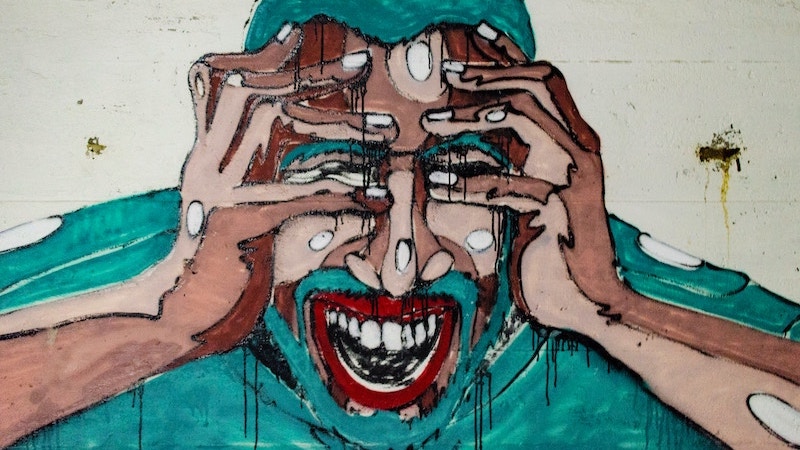
The British Mental Health Foundation’s statistics for 2022-23 show that 37.1% of women and 29.9% of men reported “high levels of anxiety.” This rose from 21.8% and 18.3% respectively in the period 2012-15. In other words, a 70% increase for women and 63% for men from the earlier baseline. Where does this endemic anxiety stem from? The culprit appears to be our endocrine system.
What is the endocrine system?
From Wikipedia:
“The endocrine system is a messenger system comprising feedback loops of the hormones released by internal glands of an organism directly into the circulatory system, regulating distant target organs… In humans, the major endocrine glands are the thyroid gland, parathyroid gland, pituitary gland, pineal gland, the testes (male), ovaries (female), and the adrenal glands.”
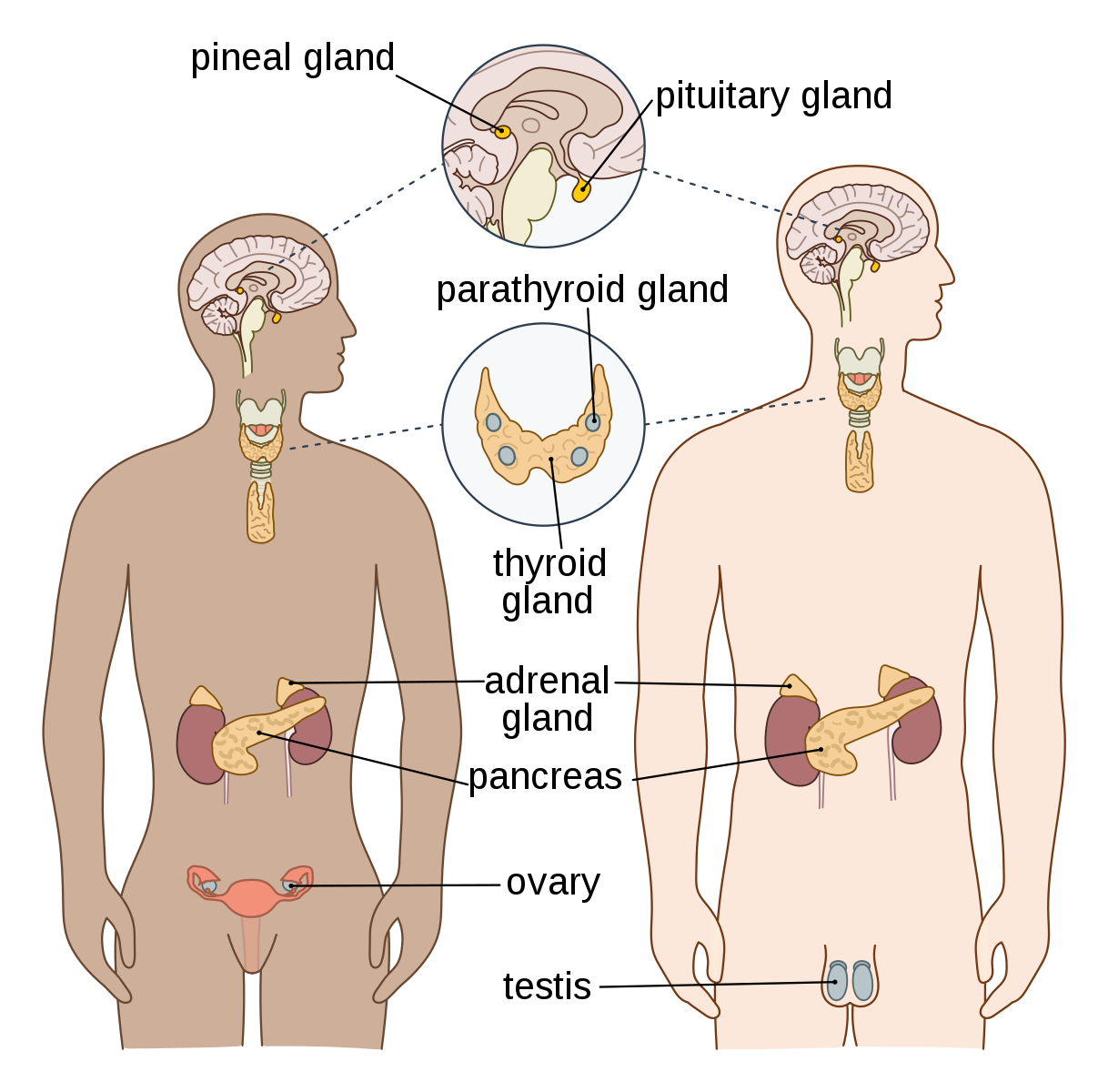
Image: Endocrine English by OpenStax & Tomáš Kebert & umimeto.org (Wikimedia / CC SA 4.0)
These last three—testes, ovaries, and adrenal glands—are the unholy trinity at the root of humanity’s core anxiety.
Most of the time, the endocrine system regulates our bodies by promoting balance, known as homeostasis. Sometimes, however, it protects us by actively promoting imbalance. A case in point: the fight-or-flight response.
The fight-or-flight response
The fight-or-flight response was first described by physiologist Walter Bradford Cannon in 1915. It’s “a physiological reaction that occurs in response to a perceived harmful event, attack, or threat to survival.” It makes us more attentive, more combative, and anticipates physical injury.
To achieve this, fight-or-flight disturbs the homeostasis of the body—our state of natural, sustainable balance, which Cannon also studied. This means fight-or-flight can only be maintained for a short time—the period of immediate danger.
This infographic from thinklikeahorse.org shows its main effects:
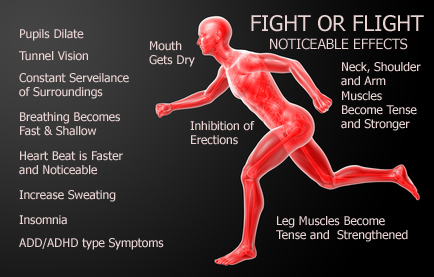
Yet there’s more going on. As well as the noticeable effects, the fight-or-flight response induces many less obvious responses.
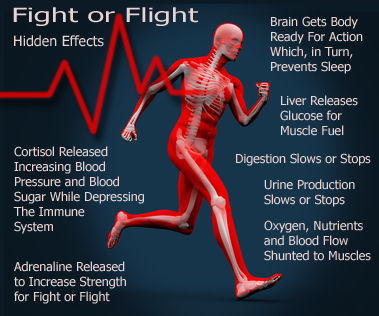
It achieves this through a temporary imbalance of two hormones: adrenaline and cortisol. Adrenaline basically functions by inducing a panic attack, which in turn induces decisive action. Cortisol then neutralises the adrenaline.
Adrenaline propels us into either fight or flight. Once the adrenaline has done its job, we rebalance through the production of cortisol.
So, we’ve looked at the endocrine system and established that it connects the testes, ovaries, and adrenals. And we’ve looked at the fight-or-flight response. We’ve established that it operates through a spike in adrenaline production by the adrenal glands.
How are these linked systems responsible for humanity’s endemic anxiety?
Desertification and the endocrine system
The answer lies in geographer James DeMeo’s Saharasia: The 4000 BCE Origins of Child Abuse, Sex Repression, Warfare and Social Violence in the Deserts of the Old World. (Yes, you’re right, this is not light bedtime reading.)
DeMeo meticulously documents how long-term drought, desertification and famine in the Sahara, Arabia, and Central Asia from around 4000 BC transformed peaceful Neolithic hunter-gatherer and early agricultural societies into violent patriarchies competing for increasingly scarce food and water sources.
DeMeo describes the profound psychological impact of famine:
“The very old and young were abandoned to die. Brothers stole food from sisters, and husbands left wives and babies to fend for themselves. While the maternal-infant bond endured the longest, eventually mothers abandoned their weakened infants and children.”
These traumatic impacts were observed as recently as the 1970s, when the Ik people of East Africa were driven into famine by conflict with neighbouring tribes.
At the deepest level, the danger of desertification and famine triggered our ancestors’ fight-or-flight response. As mentioned, this creates acute anxiety through an adrenaline spike that lasts until the danger passes and the balancing chemical, cortisol, is produced.
In a long-term drought and famine situation, lasting several thousand years, our ancestors were in constant danger—a danger they could neither fight nor fly from. As a result, the relief of cortisol never arrived.
Overproduction of adrenaline became embedded in human physiology, like a stuck throttle.
The endocrine system and genital anxiety
As we’ve seen, the ovaries and testicles are part of the endocrine system. When famine caused a continual activation of the fight-or-flight response, anxiety-inducing adrenaline was pumped directly into our ancestors’ sexual glands. This lasted over several thousand years of climate change, drought, desertification, and famine.
Analysis of stalagmites from Kuna Ba cave in northern Iraq by Professor Ashish Sinha of California State University reveals a ‘mega-drought’ as late as 675-550 BC.
Our genitals became a source of extreme anxiety.
To cope with this anxiety, humanity shut down its capacity to feel—specifically, its capacity for genital feeling.
In this shutdown, this collective, unconscious desire to reduce pain and anxiety, everything feminine became traumatic. Consequently, these societies became violently anti-feminine and anti-sexual. As DeMeo notes, “the maternal-infant bond endured the longest” but eventually even that broke.
This disconnection caused a loss of genuine emotional nurturing that is humanity’s single point of failure—what I term the ‘mother wound’.
The mother wound
Destruction of the mother-child bond created a six-way core emotional fragmentation:
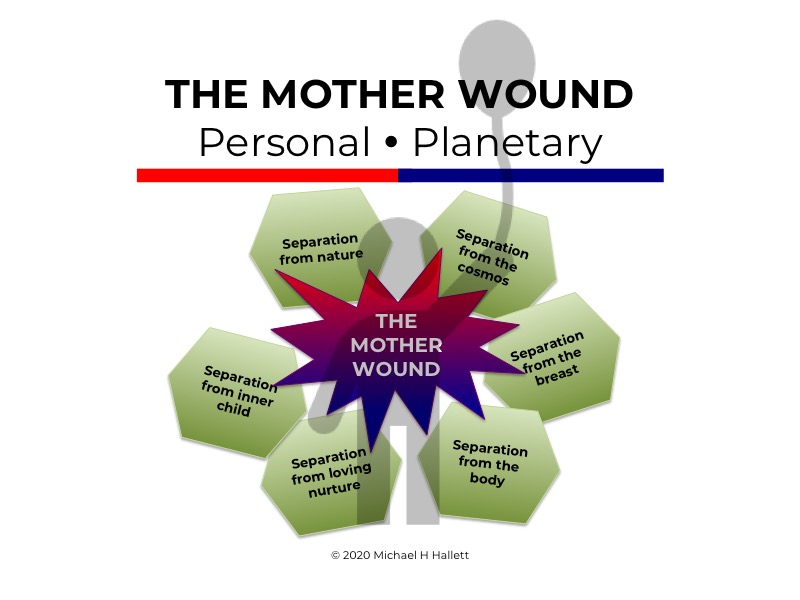
How can infants separated from everything meaningful in their lives grow into anything other than permanently anxious adults?
Psychoanalyst and natural scientist Wilhelm Reich writes that an anti-feminine and anti-sexual psychology affects us right down to the cellular level, where it creates “a perpetual state of anxiety”:
“Sexuality and anxiety are functions of the living organism operating in opposite directions: pleasurable expansion and anxious contraction.”
— Wilhelm Reich, The Function of the Orgasm
Reich writes that anxiety-based patriarchies “create the most idealistic philosophies… a fear of pleasurable excitation (pleasure anxiety) and create theories on the ‘wickedness,’ ‘sinfulness,’ and ‘destructiveness’ of pleasure… It would be afraid of any reminder of the possibility of the so ardently desired relaxation; then it would hate such a reminder, and finally it would prosecute and murder anyone who spoke about it…”
This is a succinct precis of what we naively call ‘civilization.’
From then till now
The history of civilization—the genocidal quest for surplus to counter the loss of genuine emotional nurturing—is the history of the mother wound, of the endocrine system that created it, and the anxious humanity it spawned.
Describing the shift from the peaceful Neolithic Age to the violence of the Bronze and Iron Ages in The Fall, psychology lecturer Steve Taylor writes: “The main event in human history is a sudden, massive regression—a dramatic shift from harmony to chaos, from peace to war, from life-affirmation to gloom, or from sanity to madness.”
Thanks to epigenetic inheritance, that madness is still with us today, in a world rapaciously destroying its greatest asset—Mother Nature—in pursuit of short-term consumerism, billionaire fortunes and ego gratification.
Over the millennia, the effect of the mother wound has been significantly watered down. Yet it is still with us today, evidenced by our catastrophic inability to create nurturing societies or nurture the planet we depend on.
And it is evidenced by the growing anxiety epidemic documented in the Mental Health Foundation statistics, as the increasingly sensitive younger generations sense that something is rotten in the state of humanity.
All thanks to the endocrine system, the messenger loop connecting three critical glands—the adrenals, testes, and ovaries.
Photo by Aarón Blanco Tejedor on Unsplash
